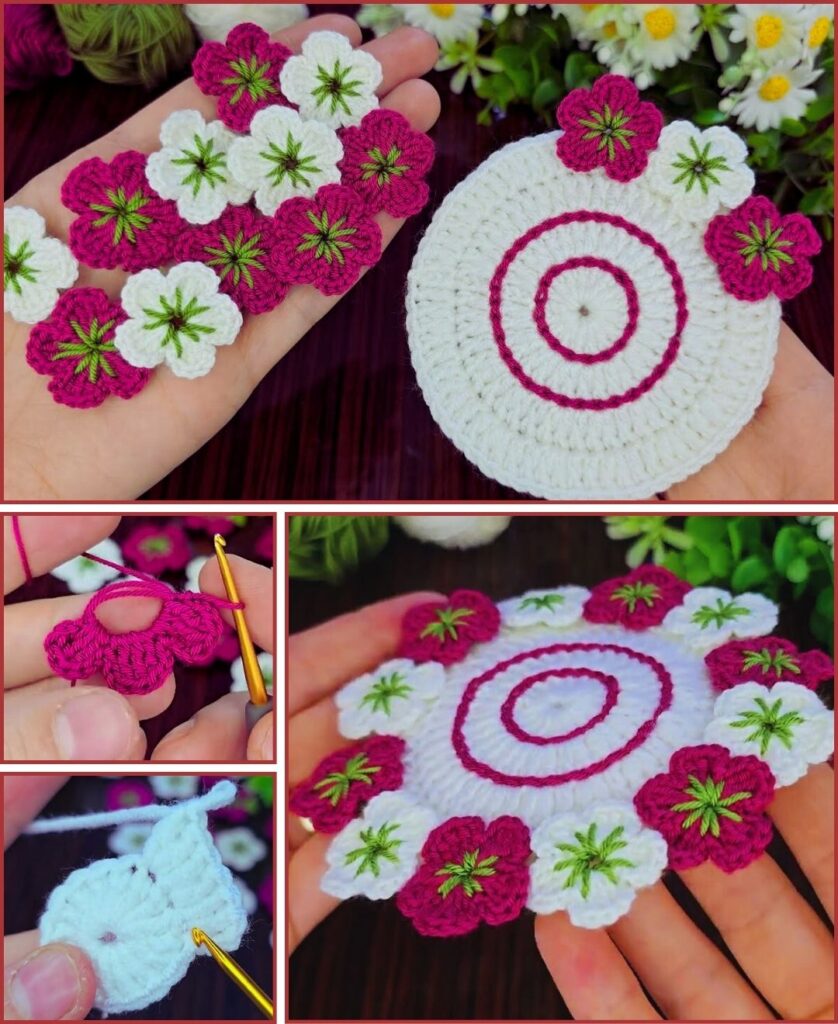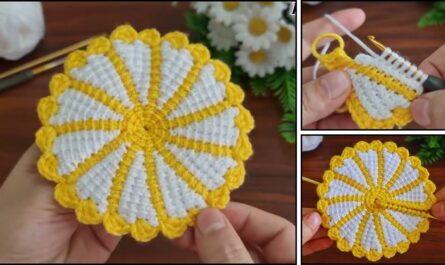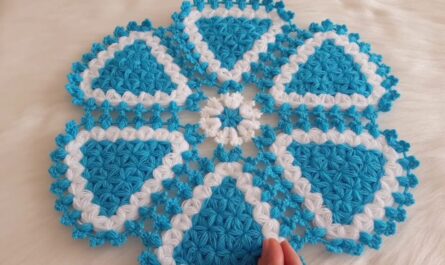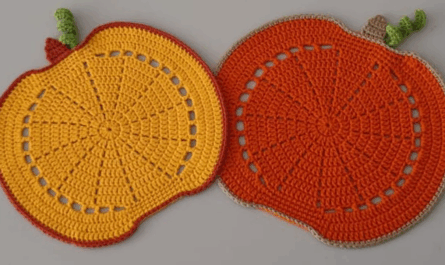You’re looking to crochet a beautiful flower coaster! This is a lovely project that’s both functional for protecting your surfaces from coffee cups and decorative, adding a charming touch to any room. For coasters, especially here in Phnom Penh’s climate, 100% cotton yarn is always the best choice because it’s absorbent, can handle heat, and is easy to wash.
This detailed tutorial will guide you through making a pretty, multi-layered flower coaster.

How to Crochet a Flower Coaster
This pattern focuses on creating a layered flower motif that’s sturdy enough to work as a coaster.
1. Essential Materials You’ll Need
- Yarn:
- Flower Center Color: A small amount of 100% Worsted Weight Cotton Yarn (think yellow, brown, or a bright contrasting color).
- Petal Color(s): Small amounts of 100% Worsted Weight Cotton Yarn for your petals. You can use one color for all petals, or change colors for different layers.
- Outer Layer/Base Color (Optional but recommended): A small amount of 100% Worsted Weight Cotton Yarn for the outermost round, helping the coaster lay flat and providing a nice border (e.g., white, cream, grey, or a color that highlights your flower petals).
- You’ll need approximately 30-40 yards (27-36 meters) of total yarn per coaster, divided among your chosen colors.
- Crochet Hook: A 4.0mm (US G/6) or 4.5mm (US 7) hook. Aim for tight tension to make sure your coaster is dense and protective. If your stitches look loose, go down a hook size.
- Scissors: For cutting yarn.
- Yarn Needle (Tapestry Needle): Crucial for weaving in all your ends.
2. Basic Crochet Stitches You’ll Use
This project uses common crochet stitches, making it quite accessible:
- Chain (ch): To begin and create spaces.
- Slip Stitch (sl st): For joining rounds and neatening.
- Single Crochet (sc): Creates a dense fabric, useful for the center and borders.
- Half Double Crochet (hdc): A medium-height stitch, good for petals.
- Double Crochet (dc): A taller stitch, used for creating the main part of the petals.
- Triple/Treble Crochet (tr): An even taller stitch, used for more prominent petals or dimension.
- Magic Ring (MR): (Also known as Magic Circle). This is the best way to start the center of your flower for a perfectly tight, hole-free beginning. An alternative chain method is also provided.

The Flower Coaster Pattern
We’ll build this flower in layers, which naturally gives it a pretty 3D effect. You’ll be changing colors at the end of each section.
Abbreviations (US Crochet Terms):
- ch: chain
- sl st: slip stitch
- sc: single crochet
- hdc: half double crochet
- dc: double crochet
- tr: triple crochet (or treble crochet)
- MR: magic ring
- st(s): stitch(es)
- sp: space
Part 1: Flower Center (Color A – e.g., Yellow)
- Start (Choose ONE method):
- Method A: Magic Ring (Recommended for a tighter center)
- Create a Magic Ring (MR).
- Ch 1 (does NOT count as a stitch).
- Work 8 sc into the Magic Ring.
- Gently pull the yarn tail to close the center hole tightly.
- Join with a sl st to the top of the first sc you made. (8 sc)
- Method B: Chain Method (Easier for Beginners)
- Ch 2.
- Work 8 sc into the second chain from your hook (the very first chain you made).
- Join with a sl st to the top of the first sc you made. (8 sc)
- Method A: Magic Ring (Recommended for a tighter center)
- Fasten off Color A, leaving a short tail to weave in.

Part 2: First Petal Layer (Color B – e.g., Pink)
This layer will create 8 distinct petals around the center.
- Join Color B with a sl st into any sc from the previous round (Round 1).
- Round 2: *Ch 2 (does NOT count as st), work (1 hdc, 1 dc, 1 hdc) into the same stitch. Sl st into the next stitch.* Repeat from * to * 7 more times.
- (You’ll have created 8 small petals, each made of hdc-dc-hdc, with a sl st in between them into the next hdc.)
- Fasten off Color B, leaving a short tail to weave in.
Part 3: Second Petal Layer (Color C – e.g., Purple or a deeper pink)
This layer will sit behind the first layer, giving your flower more fullness and a 3D effect. You’ll work into the slip stitches or spaces that are behind the petals of Round 2.
- Join Color C with a sl st into any sl st from Round 2 (these are the slip stitches you made into the Round 1 sc stitches, connecting your petals). You’ll be inserting your hook behind the previously made petals.
- Round 3: Ch 3 (counts as 1 dc). Work (1 dc, 1 tr, 1 dc) into the same slip stitch.
- *Sl st into the next sl st (between petals from Round 2). Ch 3 (counts as 1 dc), work (1 dc, 1 tr, 1 dc) into the same sl st.*
- Repeat from * to * 6 more times. Sl st into the next sl st. Join with a sl st to the top of the starting Ch 3.
- (You’ll have created 8 larger petals, each made of dc-tr-dc, appearing to pop up from behind the first layer.)
- Fasten off Color C, leaving a short tail to weave in.

Part 4: Outer Layer / Coaster Base (Color D – e.g., White/Cream)
This final layer will solidify the coaster and make it flat and sturdy.
- Join Color D with a sl st into any sl st between the petals from Round 3 (behind the petals, similar to how you joined Color C).
- Round 4 (Solid Backing): Ch 1 (does NOT count as st). Work 1 sc in the same sl st.
- Work 2 sc into each dc of the petal in front. Work 3 sc into each tr of the petal in front. (Adjust this as needed to make your stitches lie flat and smoothly cover the back of the petal).
- Work 1 sc into the next sl st (between petals).
- Repeat this pattern around, covering the back of each petal cluster with sc stitches and working 1 sc into the sl st between them.
- Join with a sl st to the first sc.
- (This creates a solid, flat backing for your flower, making it a functional coaster.)
- Optional Round 5 (For a Larger, More Defined Edge): Ch 1 (does NOT count as st). Sc in each sc around. Join with a sl st to the first sc.
- This adds a neat border and makes the coaster slightly larger and more robust.
- Fasten off Color D, leaving a tail of about 6-8 inches (15-20 cm).
Finishing Your Flower Coaster
- Weave in All Ends: This is a crucial step for a neat and durable coaster. Use your yarn needle to carefully weave in every single yarn tail from all your color changes. Hide them securely within the stitches on the back of the coaster.
- Blocking (Highly Recommended):
- Gently wet your entire flower coaster (you can spray it or immerse it in cool water).
- Carefully squeeze out excess water (do not wring!).
- Lay it flat on a clean towel or a foam blocking mat. Gently shape the coaster into a perfect circle (or the shape it naturally wants to be) and arrange the flower petals nicely. You can use rust-proof pins to hold the petals in place if needed.
- Allow it to air dry completely. Blocking makes a huge difference in the final appearance, making your coaster lay perfectly flat and showcasing its beautiful 3D details.

Tips for Making Beautiful Flower Coasters
- Color Choices: This is where you can truly make it your own! Experiment with different color combinations for the center and petal layers. You can go for bright, contrasting colors, or a gradient of shades for a more subtle, elegant look.
- Tension is Key: Consistent, firm tension is important for a coaster that lays flat and effectively protects surfaces. If your coaster starts to ruffle, your tension might be too loose or you might have too many stitches; if it cups, your tension might be too tight.
- Read Carefully: Especially when changing colors or switching between layers, pay close attention to where you’re joining and starting new stitches (i.e., into the slip stitch between petals, not into the petals themselves, for the back layers).
- Practice Makes Perfect: If your first coaster isn’t perfect, don’t worry! Crochet is a skill that improves with practice, and each one you make will likely look better than the last.
You’ve now created a wonderfully charming and functional flower coaster! These make excellent gifts or a vibrant addition to your own home decor.




